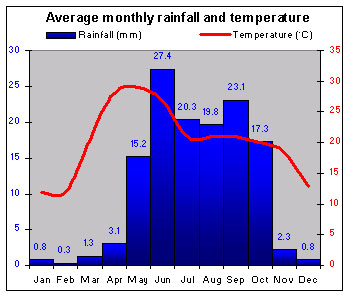COUNTRY INFORMATION |
Introduction |
Largest and most populous of the states of the Central American isthmus, Guatemala was home to the ancient Mayan civilization. Its fertile Pacific and Caribbean coastal lowlands give way to the highlands which dominate the country. Independent since 1838, Guatemala's history since 1954 has been one of military rule. Civilian rule returned in 1986, but 60% of people continue to live below the poverty line. |
|
Climate |
 |
The climate varies with altitude: daytime temperatures average 28°C (82°F) in tropical coast areas and 20°C (68°F) in the more temperate central highlands. |
|
People |
| Languages |
Quiché, Mam, Cakchiquel, Kekchí, Spanish |
|
| URBAN/RURAL POPULATION DIVIDE |
|
|
|
More than half of Guatemalans are Amerindians, descendants of the original Maya. Culture and language distinguish them from ladino groups. Ladinos include a white elite, a large mixed race group, and also Amerindians rejecting traditional dress and language to avoid discrimination. Political power and 65% of land are held by a few ladino families. Amerindians mainly live in the highlands, by subsistence farming. In a 1999 plebiscite, ladinos rejected proposed reforms recognizing 23 Amerindian languages and the right of Amerindians to have judicial hearings in their own languages. |
|
Economy |
| GNP (US$) |
19164
|
M |
GNP World rank |
67
|
|
| Inflation |
6 |
% |
Unemployment |
8 |
% |
|
StrengthsMain exports are coffee, sugar, beef, bananas, and cardamom. Privatizations boost foreign investor confidence. WeaknessesTraditional exports vulnerable to world price changes. Shaky financial system. Inequalities in land and wealth limit domestic market. Tax evasion. |
|
Politics |
| Lower house |
Last election |
1999 |
Next election |
2003 |
| Upper house |
Last election |
Not applicable |
Next election |
Not applicable |
|
A military government which came to power in 1954 with US backing brutally suppressed opposition and persecuted the highland Amerindians until the return of democracy in 1986. Civil war effectively continued until President Arzú of the PAN concluded a peace agreement with the Guatemalan National Revolutionary Unity (URNG) guerrillas in 1996. The 36-year war had claimed 200,000 lives, mostly innocent civilians. In presidential elections in 1999 Alfonso Portillo of the right-wing FRG, running on a strong law and order platform, defeated the PAN candidate. Efraín Ríos Montt, military ruler in 1982–1986, remains a force in politics and in 2001 was elected president of the Congress, despite being investigated by a Spanish court on charges of genocide. Constant tension exists between the legislative and executive branches of government. |
|
Resources |
| Minerals |
Oil, antimony, lead, tungsten, nickel, copper |
|
| Oil reserves (barrels) |
196m barrels |
Oil production (barrels/day) |
25,503 b/d |
|
Agriculture provides over 20% of GDP and about 70% of export earnings. Guatemala is the world's largest producer of cardamom. The civil war hindered the exploitation of oil reserves and hydroelectric potential. |
|
Health |
| Life expectancy |
65 |
Life expect. World rank |
125 |
| Population per doctor |
1111 |
Infant mortality (per 1000 births) |
39 |
|
|
|
| Principal causes of death |
Gastrointestinal infections, tuberculosis, heart disease, violence |
|
Health spending is a budget priority as a result of pressure from the UN and multilateral lenders. Gastrointestinal and other infections directly linked to poverty remain the main causes of death. |
|
Education |
| Literacy |
69 |
% |
Expend. % GNP |
2 |
%
|
|
| PERCENTAGE OF POPULATION IN FULL TIME EDUCATION |
|
| Primary |
100 |
% |
Secondary |
33 |
% |
Tertiary |
9 |
% |
|
Education is only for the privileged. A literacy rate of under 70% makes Guatemala one of the worst educated countries in Latin America. |
|
Wealth |
| Cars |
52 |
per 1,000 population |
| Telephones |
57 |
per 1,000 population |
| Televisions |
61 |
per 1,000 population |
|
Poverty has risen since 1980: 60% of the population now live below the poverty line. The richest 10% control an estimated 46% of the national wealth.
|
History |
Site of the Mayan civilization, Guatemala declared independence from Spain in 1821. It became fully independent in 1838. - 1954 US-backed coup topples reformist government.
- 1966–1984 Counterinsurgency war; highlands "pacification."
- 1986–1993 Return of civilian rule; President Serrano elected. Flees country after abortive "self-coup."
- 1996 President Arzú elected; peace deal with URNG guerrillas, ending 36 years of civil war.
- 1998 Bishop Juan Gerardi, human rights campaigner, murdered.
- 1999 "Truth Commission" blames army for most human rights abuses. Portillo and FRG win elections.
|
|